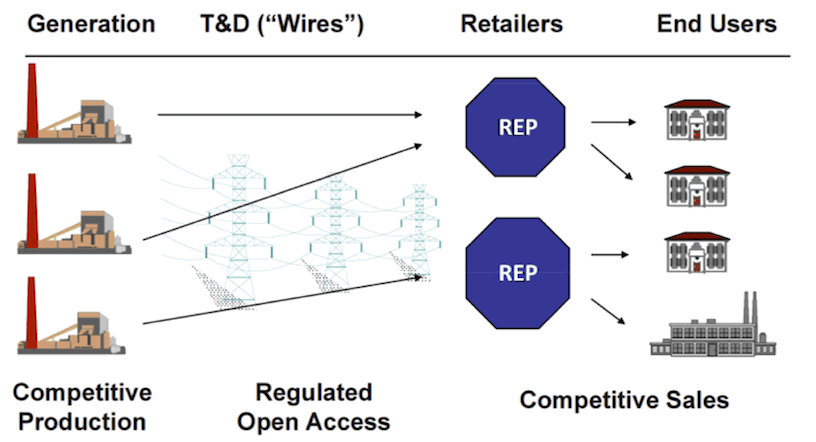Most of Texas' electricity markets – 75% of the state's land and 85% of its electric load – are managed by the Electric Reliability Council of Texas (ERCOT), which also functions as an Independent System Operator (ISO), also known as a Regional Transmission Organization (RTO). The geographies not managed by ERCOT are either: 1) served by municipalities or cooperatives, each with their own governance and management guidelines; or 2) located at the outer boundaries of the state in the territory of another RTO. Our discussion here is limited to ERCOT territory.
The regulating authority overseeing the state's investor-owned utilities (IOUs) and privately owned utilities is the Public Utility Commission of Texas (PUCT). Once again, municipalities and cooperatives are not regulated by PUCT.
In 1995, the Texas legislature enacted the Public Utility Regulatory Act of 1995, which was further amended by Senate Bill 373, to promote competition in the wholesale electricity markets served by ERCOT. Wholesalers sell large volumes of high-voltage electricity to a small number of retailers, who then resell the electricity, at lower voltages, to a large number of retail customers. According to PUCT documents [1], SB373 affected electric markets in the following ways:
- Required utilities to provide non-discriminatory, open access to transmission for wholesale providers of electricity.
- Recognized new, unregulated participants in the ERCOT wholesale market:
- Independent wholesale generators.
- Power marketers (who contract for electricity, but do not own generating equipment).
- In 1999, the Texas legislature went further to require ERCOT to create competition in retail markets by passing Senate Bill 7. This bill:
- Established an effective date of January 1, 2002.
- Allowed municipal utilities and cooperatives to "opt-in" to retail choice.
- Allowed for reimbursement of incumbent utilities' "stranded costs" resulting from loss of electricity customers.
- Designated a "provider of last resort" (POLR) in all affected areas – generally the incumbent utility.
- Designated ERCOT as market facilitator.
- Required each former monopoly provider to "unbundle" (that is, to separate) its operations into three distinct entities [2]:
- The deregulated power generating company, which owns and operates the electric power plants and sells its power into the wholesale power market.
- The regulated transmission and distribution company, which owns and operates the wires to transport power from power plants to all customers within a certain geographical area.
- The deregulated retail electric provider (REP), which purchases wholesale power from power-generating companies and re-sells the power to customers. The retail provider is responsible for all interaction with the customer, including billing the customer for transmission and distribution services and for the power purchases. However, a retail provider may not own generation.
- Required certification of REPs (whose prices would no longer be regulated).
- Transmission and distribution businesses remain regulated utilities (prices based on cost of service plus an approved margin).

Source: Tom Hunter, Public Utility Commission of Texas, Electric and Gas Reliability Workshop, April 17, 2012 [1].
See also: "The Electricity Grid" figure.
How retail choice works in Texas
As a result of the above changes, each retail customer today is served by a local distribution utility (a regulated monopoly), which carries over its wires the electricity that the end-user purchases from the customer's chosen REP (a competitive provider). The local utility is responsible for billing the customer for all electricity charges, including connection, metering, etc. plus the REP's energy charges, which are passed through to the customer without mark-up.
As of 2015, there were 179 competitive REPs in the state. Individuals and businesses are able to shop for and purchase their energy from any of these certified REPs. PUCT maintains a website, www.powertochoose.org, where a consumer can input a ZIP code and answer a few questions about typical electricity usage and billing preferences and then see all REPs and their rates serving that ZIP code [3]. Options include:
- Fixed vs. variable vs. indexed (market) rate per kWh
- Length of contract
- Cancellation fee
- Fixed monthly charge, or flat fee
- Percentage renewable energy
- Rates per kWh for first 500, next 500, then next 1,000 of monthly use
- Time of Use rates (weekday/weekend or day/night)
For each plan, REPs are required to provide an Electric Facts Label which spells out the details of the plan.
Any person or company who does not choose a REP will receive their energy from the designated POLR for their area, depending on their customer class (residential, small/medium/large non-residential).
In the 15 years since retail competition started, several consumer protections have been put in place to guard consumers against fraud and abuse such as "slamming" (switching one's service without their permission) and "cramming" (adding charges to one's bill).
According to Wikipedia, "Since 2002, approximately 85% of commercial and industrial consumers have switched power providers at least once. Approximately 40% of residential consumers in deregulated areas have switched from the former incumbent provider to a competitive REP." [4]
One final note: Texas does not have a community retail choice option as is available in California or Illinois through which citizens in a municipality, town, county, or other jurisdiction can choose a REP for the entire group. In Texas, the choice is left to each electricity customer on an opt-in basis.
Sources:
- [1] https://www.puc.texas.gov/agency/topic_files/101/PUC-History_Dereg_ERCOT.pdf
- [2] http://tcaptx.com/downloads/HISTORY-OF-DEREGULATION.pdf
- [3] http://www.powertochoose.com/en-us/
- [4] https://en.wikipedia.org/wiki/Deregulation_of_the_Texas_electricity_market
Other resources: